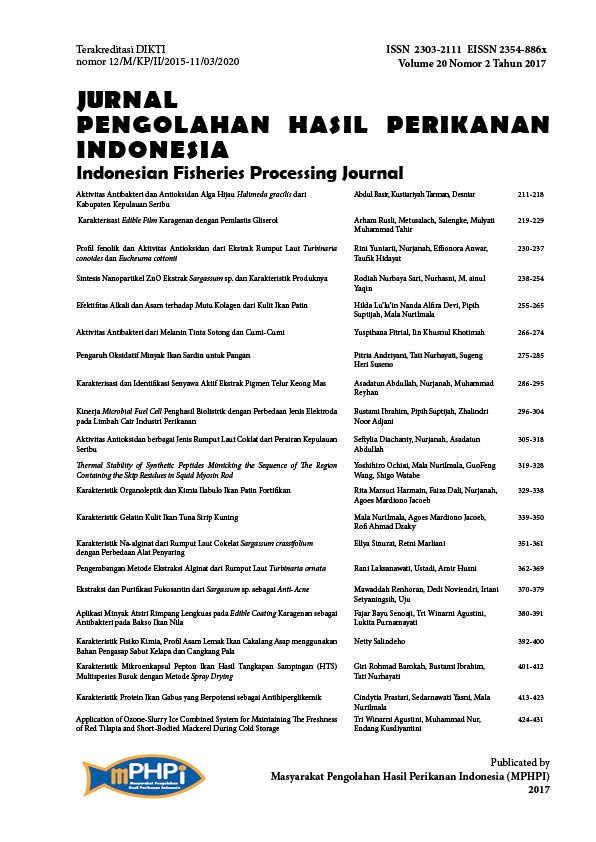Antibacterial Activity of Melanin from Cuttlefish and Squid Ink
Abstract
Marine environment comprises of many organism which are known to posses bioactive compound as a common means of self-defense or for the protection of eggs and embryos. Class Cephalopods (such as squid
and cuttlefish) are notable for their defences, such as jetting escape movements, changes in colouration, toxic venom and inking.This study aims to compare the antibacterial activity of melanin from cuttlefish ink (Sepia sp.) with squid ink (Loligo sp.) against E. coli. Extraction and purification studies were carried out on Sepia and Loligo melanin using a hydrochloric acid 0,5M treatment under mechanical.The melanins were obtained and further evaluated their activity by direct contact methods between melanin and E. coli in nutrient broth.Total microbes was counted by total plate count.Both inks also was tested their activity against E. coli. The results showed that melanin from cuttlefish and squid inks had inhibitory activity at concentrations of 10 mg / ml and 20 mg / mL, respectively reaching 99.99% against E. coli.The inks of both Cephalopods at the same concentration as melanin, did not show any inhibitory activity against E. coli. The melanin of Sepia sp. have a higher antibacterial activity than the melanin of Loligo sp.
and cuttlefish) are notable for their defences, such as jetting escape movements, changes in colouration, toxic venom and inking.This study aims to compare the antibacterial activity of melanin from cuttlefish ink (Sepia sp.) with squid ink (Loligo sp.) against E. coli. Extraction and purification studies were carried out on Sepia and Loligo melanin using a hydrochloric acid 0,5M treatment under mechanical.The melanins were obtained and further evaluated their activity by direct contact methods between melanin and E. coli in nutrient broth.Total microbes was counted by total plate count.Both inks also was tested their activity against E. coli. The results showed that melanin from cuttlefish and squid inks had inhibitory activity at concentrations of 10 mg / ml and 20 mg / mL, respectively reaching 99.99% against E. coli.The inks of both Cephalopods at the same concentration as melanin, did not show any inhibitory activity against E. coli. The melanin of Sepia sp. have a higher antibacterial activity than the melanin of Loligo sp.
Authors
FitrialY., & KhotimahI. K. (2017). Antibacterial Activity of Melanin from Cuttlefish and Squid Ink. Jurnal Pengolahan Hasil Perikanan Indonesia, 20(2), 266-274. https://doi.org/10.17844/jphpi.v20i2.17907
Authors who publish with this journal agree to the following terms:
- Authors retain copyright and grant the journal right of first publication with the work simultaneously licensed under a Creative Commons Attribution License that allows others to share the work with an acknowledgement of the work's authorship and initial publication in this journal.
- Authors are able to enter into separate, additional contractual arrangements for the non-exclusive distribution of the journal's published version of the work (e.g., post it to an institutional repository or publish it in a book), with an acknowledgement of its initial publication in this journal.





